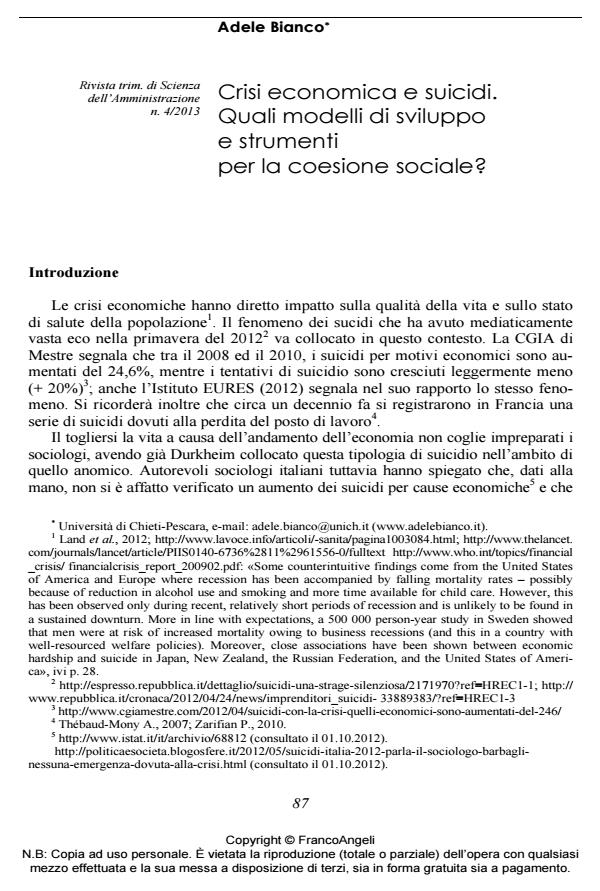Crisi economica e suicidi. Quali modelli di sviluppo e strumenti per la coesione sociale?
Titolo Rivista RIVISTA TRIMESTRALE DI SCIENZA DELL’AMMINISTRAZIONE
Autori/Curatori Adele Bianco
Anno di pubblicazione 2014 Fascicolo 2013/4
Lingua Italiano Numero pagine 17 P. 87-103 Dimensione file 463 KB
DOI 10.3280/SA2013-004005
Il DOI è il codice a barre della proprietà intellettuale: per saperne di più
clicca qui
Qui sotto puoi vedere in anteprima la prima pagina di questo articolo.
Se questo articolo ti interessa, lo puoi acquistare (e scaricare in formato pdf) seguendo le facili indicazioni per acquistare il download credit. Acquista Download Credits per scaricare questo Articolo in formato PDF

FrancoAngeli è membro della Publishers International Linking Association, Inc (PILA)associazione indipendente e non profit per facilitare (attraverso i servizi tecnologici implementati da CrossRef.org) l’accesso degli studiosi ai contenuti digitali nelle pubblicazioni professionali e scientifiche
Argomento del contributo è il fenomeno dei suicidi che si sono verificati a causa della crisi economica del 2008 e che ha avuto vasta eco mediatica. Prendendo spunto dal pensiero di Durkheim, ci si interroga sulla possibilità di intervento per contenerli. Come si ricorderà Durkheim aveva trattato il tema del togliersi la vita per cause economiche, collocando questa tipologia di suicidio nell’ambito di quello anomico (primo paragrafo). Inoltre, il progetto di Durkheim era quello di un ripristino delle Corporazioni quale strumento atto a garantire, sviluppare e cementare l’unità all’interno delle società industriali (secondo paragrafo). Nel terzo paragrafo verranno esaminate l’attuale presenza e la funzione nel nostro ordinamento degli Enti Bilaterali, quale modello alternativo di relazioni industriali inte- ressante le piccole imprese e i loro lavoratori. Ne verranno sinteticamente illustrati i compiti, analizzata la composizione interna, dato conto della loro funzione. Il riferimento agli Enti Bilaterali è volto a comprendere, nel quarto paragrafo, in quale misura essi possano oggi richiamare le Corporazioni durkheimiane. Dall’analisi comparativa che svolgeremo, verificheremo se sia possibile organizzare gli Enti Bilaterali come modelli di intervento e strumenti volti a tutelare la coesione sociale, ovvero a ripristinarla, nella convinzione "durkheimiana" che la sua mancanza sia la ragione dei suicidi che le cronache registrano.
Parole chiave:Crisi economica, suicidi, Enti Bilaterali
Adele Bianco, Crisi economica e suicidi. Quali modelli di sviluppo e strumenti per la coesione sociale? in "RIVISTA TRIMESTRALE DI SCIENZA DELL’AMMINISTRAZIONE" 4/2013, pp 87-103, DOI: 10.3280/SA2013-004005